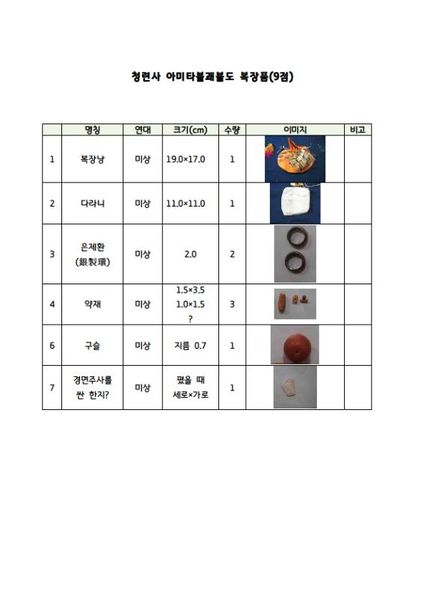양주 청련사 아미타불괘불도 및 복장물
| 양주 청련사 아미타불괘불도 및 복장물 Hanging Painting and Excavated Relics of Cheongnyeonsa Temple, Yangju (Amitabha Buddha) |
|
 양주 청련사 아미타불괘불도 및 복장물, 국가문화유산포털, 문화재청. |
|
| 대표명칭 | 양주 청련사 아미타불괘불도 및 복장물 |
|---|---|
| 영문명칭 | Hanging Painting and Excavated Relics of Cheongnyeonsa Temple, Yangju (Amitabha Buddha) |
| 한자 | 楊州靑蓮寺 阿彌陀佛掛佛圖 및 腹藏物 |
| 주소 | 경기도 양주시 장흥면 권율로 169 |
| 국가유산 종목 | 경기도 유형문화재 제365호 |
| 지정(등록)일 | 2020년 12월 3일 |
| 분류 | 유물/불교회화/괘불화/미륵불도 |
| 시대 | 조선시대 |
| 수량/면적 | 불화 1점, 복장물 9점 |
| 웹사이트 | 양주 청련사 아미타불괘불도 및 복장물, 국가문화유산포털, 문화재청. |
해설문
국문
이 괘불은 아미타불을 중심으로 좌우에 관음보살과 대세지보살이 크게 부각되고, 아래쪽에는 가섭과 아난존자를, 가장 아래쪽에 사자를 탄 문수보살과 코끼리를 타고 있는 보현보살이 그려져 있다. 세로가 6m가 넘는 이 불화는 야외에서 의식이 행해질 때 법당 앞마당에 걸어 주존(主尊)이 되었다.
1937년에 제작된 이 괘불은 일제강점기에도 청련사에서 의식이 거행되었음을 보여준다. 특이하게도 부처의 대좌 아래에 사자가 그려져 있다. 아미타삼존불의 신체 부분에 사용되었던 노란색, 그리고 인물이나 구름 등에 사용된 음영법은 근대기 불화 양식이다. 화기 일부가 손상되어 전체의 모습을 알 수 없지만 근대기 승려이자 학자인 퇴경당 권상노가 회주*로 기록되었고 당시 주지로는 갑득 덕봉이 기록되어 있어 불화의 조성에 관련된 인물들을 확인할 수 있다. 또한 괘불 제작 당시에 조성한 복장물**도 잘 보존되어 있다.
- 회주: 불화를 만드는 일을 이끌어 가는 사람.
- 복장물: 불상을 만들거나 칠을 다시 하면서 가슴 안쪽에 넣은 보석과 서책 등.
영문
Hanging Painting and Excavated Relics of Cheongnyeonsa Temple, Yangju (Amitabha Buddha)
A hanging banner painting was displayed outdoors on special occasions such as the Buddha’s birthday, outdoor rites, and the funerals of eminent monks.
This banner painting, which measures more than 6 m in height, was made in 1937 during the Japanese colonial period (1910-1945). It shows that large-scale outdoor ceremonies were performed in Cheongnyeonsa Temple during the Japanese colonial period when Korean Buddhism was suppressed. According to an inscription at the bottom of the painting, the Buddhist monk and scholar Gwon Sang-ro (1879-1965) led the creating process of this hanging banner painting.
The painting depicts large standing Buddhist triad with Amitabha (Buddha of the Western Paradise) in the center, flanked by Avalokitesvara (Bodhisattva of Great Compassion) and Mahasthamaprapta (Bodhisattva of Wisdom and Strength). The depiction of a lion below Amitabha is an unique feature. Below the triad are the Buddha’s two most renowned disciples, Maha Kasyapa and Ananda. At the very bottom are Manjusri (Bodhisattva of Wisdom and Insight) and Samantabhadra (Bodhisattva of Great Conduct), depicted riding a lion and elephant, respectively. The painting’s style is characteristic of the 20th century, as seen in the yellow color of the triad’s bodies and the shading technique applied to the figures and the clouds.
The painting is accompanied by nine relics that were created at the same time. They are well preserved and include an ensouling pouch, a Buddhist incantation (dharani), silver rings, and a bead.
영문 해설 내용
괘불은 석가탄신일, 야외 법회, 고승의 장례식 등에서 야외에 걸어놓고 의식을 행하는 데 쓰였다.
세로 길이가 6m가 넘는 이 불화는 일제강점기인 1937년에 제작되었다. 한국 불교가 탄압받던 일제강점기에도 청련사에서는 대규모의 야외 의식이 거행되었음을 보여주는 자료이다. 그림 하단에 남아있는 화기에 따르면 승려이자 불교학자인 권상로(1879-1965)가 이 괘불의 조성 과정을 이끌었다.
아미타불을 중심으로 양옆에 관음보살과 대세지보살이 배치된 삼존이 크게 그려져 있다. 부처 아래에 사자가 그려져 있는 점이 특이하다. 삼존의 아래에는 부처의 여러 제자 중 으뜸이라고 하는 가섭존자와 아난존자가 있고, 가장 아래에는 사자를 탄 문수보살과 코끼리를 타고 있는 보현보살이 그려져 있다. 아미타 삼존의 신체가 노란색으로 칠해진 것과 인물과 구름 등에 사용된 음영법은 20세기 불화 양식이다.
또한 복장낭, 다라니, 은제환, 구슬 등 괘불 제작 당시에 함께 조성한 9점의 유물들도 잘 보존되어 있다.
